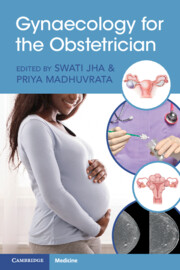Book contents
- Gynaecology for the Obstetrician
- Gynaecology for the Obstetrician
- Copyright page
- Dedication
- Contents
- Contributors
- Foreword
- Preface
- Chapter 1 Ovarian Cysts in Pregnancy
- Chapter 2 Fibroids in Pregnancy
- Chapter 3 Cervical Abnormalities in Pregnancy
- Chapter 4 Vulval Disorders in Pregnancy
- Chapter 5 Congenital Uterine Malformations and Vaginal Anomalies
- Chapter 6 Vaginal Prolapse and Previous Prolapse Surgery
- Chapter 7 Urinary Tract Problems in Pregnancy
- Chapter 8 Previous Third and Fourth Degree Tears
- Chapter 9 Management of Post-Partum Retained Placental Remnants
- Chapter 10 Gestational Trophoblastic Disease (GTD)
- Chapter 11 Female Genital Mutilation
- Chapter 12 Ovarian and Cervical Malignancy in Pregnancy
- Chapter 13 Post-Partum Contraception
- Chapter 14 Pregnancy Associated Breast Cancer
- Index
- References
Chapter 7 - Urinary Tract Problems in Pregnancy
Published online by Cambridge University Press: 14 July 2023
- Gynaecology for the Obstetrician
- Gynaecology for the Obstetrician
- Copyright page
- Dedication
- Contents
- Contributors
- Foreword
- Preface
- Chapter 1 Ovarian Cysts in Pregnancy
- Chapter 2 Fibroids in Pregnancy
- Chapter 3 Cervical Abnormalities in Pregnancy
- Chapter 4 Vulval Disorders in Pregnancy
- Chapter 5 Congenital Uterine Malformations and Vaginal Anomalies
- Chapter 6 Vaginal Prolapse and Previous Prolapse Surgery
- Chapter 7 Urinary Tract Problems in Pregnancy
- Chapter 8 Previous Third and Fourth Degree Tears
- Chapter 9 Management of Post-Partum Retained Placental Remnants
- Chapter 10 Gestational Trophoblastic Disease (GTD)
- Chapter 11 Female Genital Mutilation
- Chapter 12 Ovarian and Cervical Malignancy in Pregnancy
- Chapter 13 Post-Partum Contraception
- Chapter 14 Pregnancy Associated Breast Cancer
- Index
- References
Summary
Lower urinary tract symptoms occur commonly during pregnancy with two thirds of women reporting urinary frequency and nocturia. Stress urinary incontinence is reported by 50% of pregnant women and women who experience stress urinary incontinence during pregnancy are more likely to have persistent stress urinary incontinence post-partum. Pelvic floor muscle training is advised for women from 20 weeks of pregnancy who have a first degree relative with pelvic floor dysfunction. For women who fall pregnant following a continence procedure, delivery by Caesarean section is usually recommended. Urinary retention during pregnancy can be acute or chronic and catheterisation is the mainstay of treatment. Care needs to be taken with bladder management in women who have had spinal anaesthesia or following instrumental delivery or perineal trauma. Pregnancy in women following previous urinary tract reconstruction, renal transplantation or with congenital urological anomalies requires multidisciplinary involvement.
Keywords
- Type
- Chapter
- Information
- Gynaecology for the Obstetrician , pp. 61 - 71Publisher: Cambridge University PressPrint publication year: 2023



